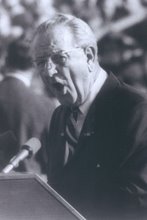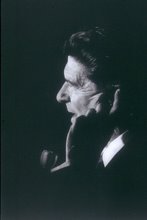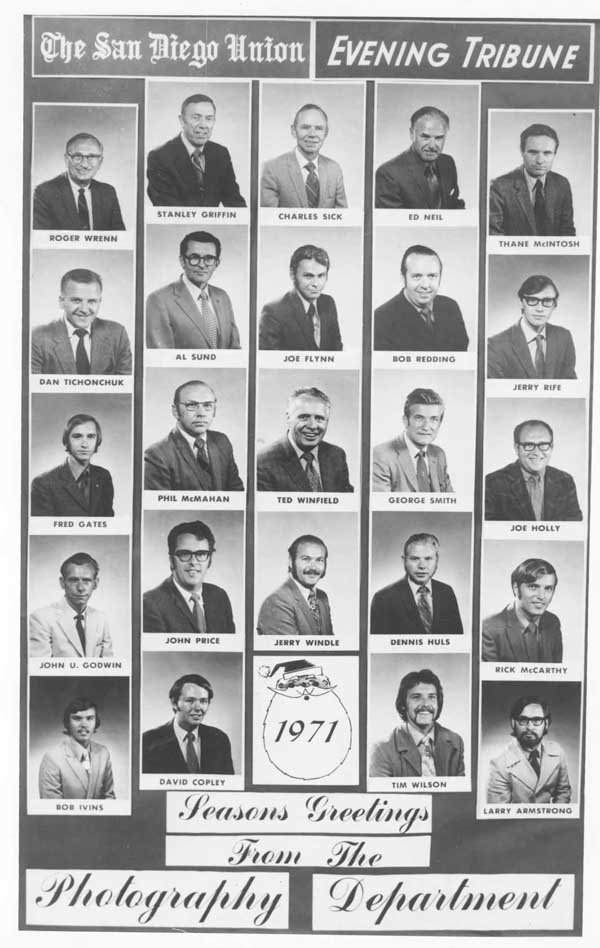I well remember the red and white Corvairs that we had as “photo cars” or “camera cars”. In their defense, they really weren’t bad little cars. I think even Ralph Nader later admitted he gave them a bit of a bad rap with some questionable engineering criticism about the handling. I owned one for a number of years. (I enjoyed it, even though the threads were stripped in one spark plug hole and it had the quirky habit of popping the hot sparkplug out of the aluminum head where it would dangle by its wire while the engine made a loud chuffing noise until I could get it shut off. I kept a pair of pliers in the car to thread it back in and we would be soon on our way.)
Back to handling... I quickly found out that if you pushed the car into a corner, the back end might well come around and meet you on the way out. But once you learned to anticipate all that weight in the back, it was really a pretty nice handling car and you could do some fancy two-wheel drifts in tight curves and come out of the turn looking like you knew what you were doing. Of course, I would never have done that in a UT car! I have owned a couple of Porsches as well, and there ain’t that much difference in the way you drive the two although the Porsche is much better balanced and refined with its small 4-cylinder engine than the heavier Corvair pancake six ever thought of being, of course.
I would have to vote a thumbs down on the white Ford Mavericks that followed the Corvairs, and Stan didn’t keep the Fords too long. I liked the red and white Chevy Novas which replaced them. They were full size cars and much more comfy, even those basic models with few amenities. I think they actually had an AM radio. After that came the Pinto station wagons which were all white with blue lettering on the doors as I recall.
Like Thane, I almost burned one of the Mavericks up covering a wild fire, somewhere around Poway. I had parked the car on a road overlooking a little arroyo with the fire on the far side. All the windows were opened in the 100 plus degree heat and wind. I left the driver’s door open and walked up the hill to get some shots of a fire crew working where the road ended. As I was shooting my pictures, I looked back and was stunned to see the fire had come around the back side of the hill behind us and was licking up to where the lonely Maverick was sitting. Fires can be very nasty things if they can sneak up behind you. I managed an explosive comment that seemed appropriate at the time, and made a dash for the car just as a single gust of wind whooshed the flames momentarily in through the open window on one side and out the open door on the other. It didn’t do any damage other than leaving a bunch of hot ashes on the front seat, so I jumped in the car with the intent of getting my backsides out of there with a maximum of haste and a minimum of bodily damage. By the time I got turned around, the fire crew was in their truck right behind me and I enthusiastically led the little bumper to bumper parade down the mountain in my stalwart little UT photo car as fast as the fire truck could push me.
Tuesday, August 28, 2007
Monday, August 27, 2007
UNION TRIBUNE PHOTO CARS
 Chuck Boyd and a U-T Corvair
Chuck Boyd and a U-T CorvairJERRY WINDLE writes:
PHOTO CARS -- I came to the U-T in August, 1967, this was just after the photo was taken that Thane mentioned with the photo guys posed around and standing on a camera car -- at the time a Corvair. I loved driving the Corvair, especially coming south on Hwy 163 and making the turn onto Fourth Ave, nice long curve and that little Corvair hugged the corner. I didn't know any better.
Someone mentioned photogs left their gear at the paper, and this was true. Eventually we had some 40+ photogs and only 8-9 cars. we'd have to come to work, get a job, sign out a car and when we returned, put the keys back on a hook. Naturally, we soon learned which cars were better than others and there was always competition trying to get the better ones. Later we discovered the keys would actually work more than one car. We'd get a key, walk all the way down to the cars only to discover the car we signed out was gone!
Not having our equipment at home with us came home when Caliente burned down. The late Ted Winfield lived in Chula Vista and had to go downtown to get his gear and a car and head back south to Tijuana. I was the next one in and didn't get there until 9-10 a.m., and it was still burning!
The cars had a roof rack so photogs could stand on top of the car, if necessary for a better point of view. Later cars proved unworthy and a few roofs got a little bent from this practice, much to the chagrin of management.
There is a photo of Jerry Rife sitting on top of a Corvair, I believe, with water up to the windows down on Market street, I think after a big rain.
Thane/Chuck was also correct in that there was an "undercover" car, again a white Corvair. Of course it stuck out like a sore thumb, and we always felt we'd be better off in the red and white car with U-T emblazened on it. Kay Jarvis and I went into Logan Heights with one once and the choke cable fell off. Thought we'd never get back. It was a piece of junk - they all were.
I am of the belief that the late Stan Griffin was responsible for the red and white color scheme with the big lightning bolt on the side and U-T "radio dispatched" cars on the side.
As mentioned, we eventually got Ford Pintos. We never had a say in what cars the paper got. In fact, I believe Thane actually sent a memo to the powers that be that he felt they were unsafe and he wanted to be on record in case something happened. Don't know if this was an urban legend or not, but the photogs admired Thane for standing up to management.
Here's a legend regarding the photo cars which IS true. The photog shall remain nameless. He went downtown on an assignment and parked in one of the Ace lots. When he came back, the car was GONE! It had been STOLEN! Of course, we all wondered who would steal such a piece of junk. Anyway, after a few weeks, we get a phone call from Ace asking if we were ever going to get our car!! Seems the photog forgot where he had parked and assumed the car had been stolen. To this day he swears it was stolen and parked in another nearby lot.
Nowadays photogs have a car assigned to them and have their gear in there with them. They have pagers and cell phones and still can never be found when needed! Ain't like the old days when we reported at our shift start time and went from there. Of course in those days we all swore it would be great to have our own company car.
JR: I should point out that Jerry is a car expert, in my opinion, although if memory serves, his main interest is in Fords. I remember someone telling me once that Jerry's wife didn't even know how many cars he owned, that he had some "hidden." Of course, in Ramona, no one hides cars. They are parked in the front yard, side yard, back yard, etc. The fellow down the road from me has eight vehicles of one kind or another on his property. Not a one of them less than 10 years old, and I assume half of them don't run -- at least they haven't moved in years.
Friday, August 10, 2007
I AM A NEWSPAPER MAN AND BOY

I was a newspaper man from the time I was about ten or eleven years old. Of course, I was a paperboy before I was a photographer. That was in the fifties when the Post Register was in its downtown plant. The press room fronted on Capital Avenue and had big picture windows so you could stand on the sidewalk and watch them print the paper. I loved to watch that. I got my papers delivered to the Highland Market, across the street from our town’s minor league ball park, along with two other paperboys. The driver would drop our wire-tied bundles about 4 oclock each afternoon. We would open them and fold the papers. I preferred to roll mine into thirds and tuck the fold inside the edge to make a nice compact roll that would throw well, (which delivery was forbidden by “Huffy” Huffman , the circulation manager) or slip into a rural mailbox neatly. The papers would fit nicely into the green canvas paperbags, the kind that you put your head through so the papers hung in pockets, front and back, like a lumpy pancho. Then I would start walking. If you had a bike, which I sometimes did, and could find where your little brother left it last, you could drape the bags over the handlebars in a precise way, making sure they could not swing sideways and throw you off on your head. Then you were set to cover your route. Mine was to the north and west.
I had the worst route that the Post Register had to offer. It was mostly in a very low income neighborhood known euphemistically as “Duttonville” after the family that settled it back during the Depression. I suppose if you took the poorest of the Joad family from “Grapes of Wrath” and intermarried them with the po’ folk from Tobacco Road on the day before payday, and put them in shacks, basement houses and various home made move-ons, you would have a large chunk of my paper route. I delivered papers there for about a year and I think I collected enough to pay my monthly bill once in all that time... twice if you count the time I left off a zero by mistake. It seems like I paid the paper 3 cents per copy and collected 5 cents from my customers and it must have been a dime for Sunday... which I delivered on Saturday. It was 35 cents a week for six days, I remember that, and I can still multiply 35 by any number of weeks in a month without thinking.
I did have some good sections on my route, down near the Snake River that runs through town. Doc Reese had an elegant home overlooking the river there and the houses were pretty nice for a block or so behind him. Then there were a couple of blocks of pretty much blue collar families... and behind them, the poorer end of my route. I didn’t know it then but I learned that the gene pool requires some serious periodic maintenance that it sometimes does not get. I also learned some second hand lessons like what the interesting results can be when a person is related to themself by marriage. And then behind these folks on my route, one of my favorite spots in all the world, the City Dump. You could find some good stuff there sometimes!!!
It was on my paper route that I learned about some of the esoteric lessons that life has to offer a young boy. Things like what an old man with no teeth talks like when he is drunk on cheap wine... and how to avoid getting sprayed when he tries to explain which week you CAN collect for the paper. Things like what the DTs do to a person... (delerium tremens.. a medical condition brought on by excessive use of alcohol with symptoms consisting of seizures, hallucinations and a loss of control of all bodily functions....nice! You can look it up if you are interested.) I recall once I saw a painter who worked for my dad and who must have been nipping at the paint thinner or something, had an attack of the DTs and was lying on his back, shaking all over. There was a piece of sandpaper under one hand and his hand was shaking so violently that I was sure he was going to sand a hole in the floor before the seizure was over. Not a particularly useful thing for a 12-year old boy to learn but at least I discovered first hand there are things in life I did NOT want to be part of.
Yes, having a paper route was an interesting segment of my early education.
I suspect this memory was a bit later, probably junior high age when I was older and wiser, but I will include it here anyway. Off to the east of Bannock Ave were I lived, were the Union Pacific rail yards complete with a real roundhouse and gigantic turntable for turning the steam engines. I can remember clearly lying in my bed and listening to the sounds of switch engines and freight cars being noisily coupled and uncoupled all night long. And occasionally, the mournful sound of a lonely whistle moaning in the night as a night train headed for the mines of Montana. I remember standing beside the track, long after I was supposed to be in bed and watching the dim lights of the caboose slowly fade into the darkness and wondering what it was like to be on board the train and heading into the fascinating unknown.
But I digress....
Beyond the yards, over near the Yellowstone Highway, north of the stock yards, was Idaho Animal Products, a rendering plant of some sort where they took in all kinds of dead animals, diseased and not, road kill, most bloated with stiff legs thrust outward rigidly. There were also parts and pieces of animals, slippery piles of unrecognizable glop, you name it. Inside that concrete building, I can imagine, they skinned the carcases out, broke them down, sliced them up, flayed them off the bones and chopped them into pieces to be rendered for the fat and lard and...well, I have no idea what they did. I do know that when the wind was right and they were cooking, the smell would gag a maggot. Across the highway and a short distance away was Ray’s In and Out, a busy little drive-in of the day. I recall how pleasant it felt when my friend, Steve Elder and I had a little excess change in our pocket and would walk the mile or so over to Ray’s for a 30-cent chocolate shake or something. A nickel more for malt. In one of those aberrations in behavior, peculiar to young boys, we somehow developed a bizarre game for the trip back home. If the Animal Products was cooking and we were feeling especially silly, we would get our shake and drink it as we walked. We timed our return so we would get to the switch yard just about the time we finished the shakes. Then we would sit downwind on the tracks, enduring in the fetid aroma from the Animal Products and making jokes and telling teenage lies until we discovered who would vomit up their shake first. Great fun! It helped to win if you had a big supper.
I just had a thought. I wonder what we smelled like when we got home? Perhaps that would explain why it was so easy to persuade our parents to let us sleep outside in the yard all summer long?
Subscribe to:
Posts (Atom)







